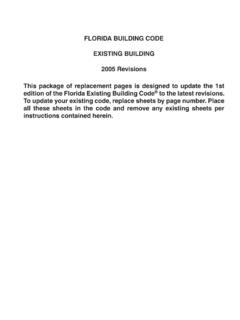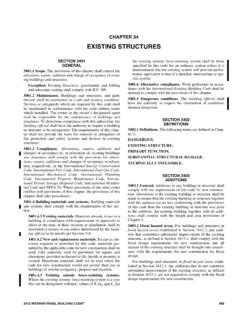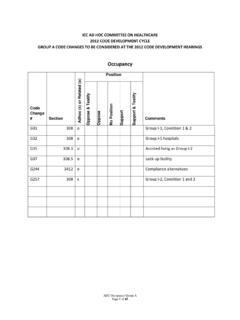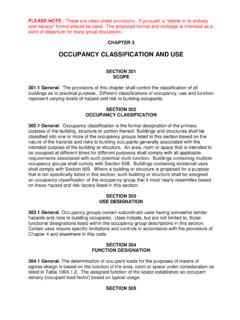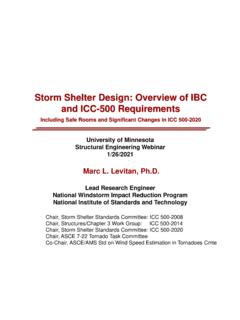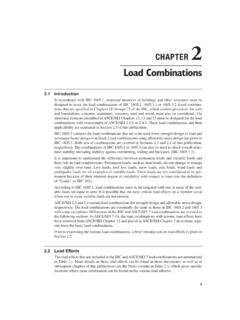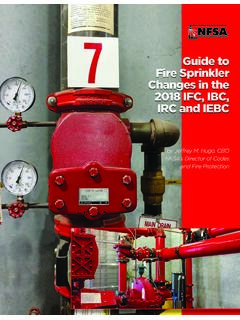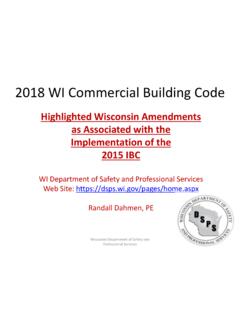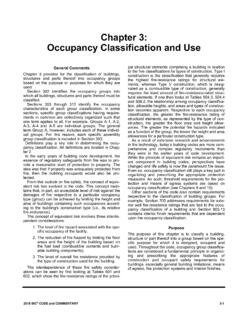Transcription of 2018 IBC UPDATE Handout - iccsafe.org
1 2018 IBC UPDATE Based on the 2018 International Building Code, (IBC ) The International Building Code (IBC ), establishes minimum regulations for building safety. This Handout will identify important changes in the IBC from 2015 to 2018 edition. Participants will be presented with those changes that will most impact their use of the code when they adopt these I-Codes. The learner will receive an overview of the most important code changes. Goal Participants will be able to use this document to identify changes between the 2015 and 2018 IBC allowing them to apply theses code requirements to design, plan submittals and/or inspection.
2 The lecture and activity format allows participants to discuss the changes, reasons for the changes, and answer knowledge review questions. Information presented will allow participants to apply these new code requirements to design, plan review, and/or inspection. Objectives Upon completion, participants will be better able to: Identify the most significant differences between the 2015 and the 2018 IBC. Explain the differences between the current and previous edition. Identify changes in organization and code requirements.
3 Identify the applicability of design, plan review and inspection requirements. Content Chapters of the IBC included in this Handout : chapter 2, Definitions chapter 3, Use and Occupancy Classification chapter 4, Special Detailed Requirements Based on Use and Occupancy chapter 5, Building Heights and Areas chapter 6, Types of Construction chapter 7, Fire and Smoke Protection Features chapter 8, Interior Finishes chapter 9, Fire Protection Systems chapter 10, Means of Egress chapter 11, Accessibility chapter 12, Interior Environment chapter 13 Energy Efficiency chapter 14, Exterior Walls chapter 15.
4 Roof Assemblies and Rooftop Structures chapter 16, Structural Design chapter 17, Special Inspections and Tests chapter 18, Soils and Foundations chapter 19, Concrete chapter 22, Steel chapter 23, Wood chapter 26, Plastic chapter 30, Elevators and Conveying Systems chapter 31, Special Construction Appendix G, Flood-Resistant Construction Appendix N, Replicable Buildings2018 IBC UPDATE Page 2 chapter 2: Definitions Code Section Section Title Description of Change 2018 2015 202 202 Definitions (Several definitions have been added to this edition of the IBC, as well as deleting and revising existing definitions.)
5 New definitions include Greenhouse and Repair garage . The definition for Sleeping unit has been clarified while Ambulatory care facility and Clinic, outpatient have been deleted. GREENHOUSE. A structure or thermally isolated area of a building that maintains a specialized sunlit environment used for, and essential to, the cultivation, protection or maintenance of plants. REPAIR GARAGE. A building, structure or portion thereof used for servicing or repairing motor vehicles. SLEEPING UNIT. A room or space in which people sleep, which can also include single unit providing rooms or spaces for one or more persons that includes permanent provisions for sleeping, and can include provisions for living, eating, and either sanitation or kitchen facilities but not both.
6 Such rooms and spaces that are also part of a dwelling unit are not sleeping units. AMBULATORY CARE FACILITY. CLINIC, OUTPATIENT. chapter 3: Use and Occupancy Code Section Section Title Description of Change 2018 2015 Clarification Classification of Outdoor Areas It has been clarified that occupied roofs are to be assigned one or more occupancy classifications in a manner consistent with the classification of uses inside the building, based upon the fire and life safety hazards posed by the rooftop activities.
7 Clarification Assembly Use of Greenhouses Classification Where the use of the greenhouse is assembly in nature due to public access for the viewing of plants, classification as a Group A-3 occupancy is appropriate. Clarification Mercantile Use of Greenhouses Classification Where a greenhouse is provided with public access for the purpose of the display and sale of plants, a Group M occupancy shall be assigned. , Clarification , Classification of Congregate Living Facilities Dormitories and similar nontransient uses now are to be considered as Group R-3 occupancies where the occupant load is 16 or less.
8 In addition, transient lodging houses, such as bed-and-breakfast establishments, can only be considered as Group R-3 occupancies where their total occupant load is 10 or less. 2018 IBC UPDATE Page 3 chapter 3: Use and Occupancy, Continued Code Section Section Title Description of Change 2018 2015 Modification Owner-Occupied Lodging Houses The criteria permitting compliance with the IRC for the design and construction of owner-occupied lodging houses has been expanded by now also requiring that the total number of lodging house occupants be limited to 10.
9 Modification Classification of Accessory Storage Spaces Regardless of size, storage rooms and spaces that are accessory to other uses are to be classified as part of the occupancy to which they are accessory. Clarification Classification of Agricultural Greenhouses Because a Group U occupancy includes those low-hazard structures that do not conform to any other specific occupancy classification, it has been clarified that greenhouses are only to be considered as Group U where they are not more appropriately classified as one of the other occupancies established in the IBC.
10 chapter 4: Special Requirements for Use and Occupancy Code Section Section Title Description of Change 2018 2015 Modification Type of Construction in High-Rise Buildings The reduction in the minimum required fire-resistance ratings for certain building elements of high-rise buildings is no longer applicable to Group H-2, H-3 and H-5 occupancies due to the high physical hazard level such uses pose. Modification Enclosure of Atriums The requirement that those spaces not separated from an atrium be accounted for in the design of the smoke control system now applies only in those cases where the atrium is provided with a smoke control system.
